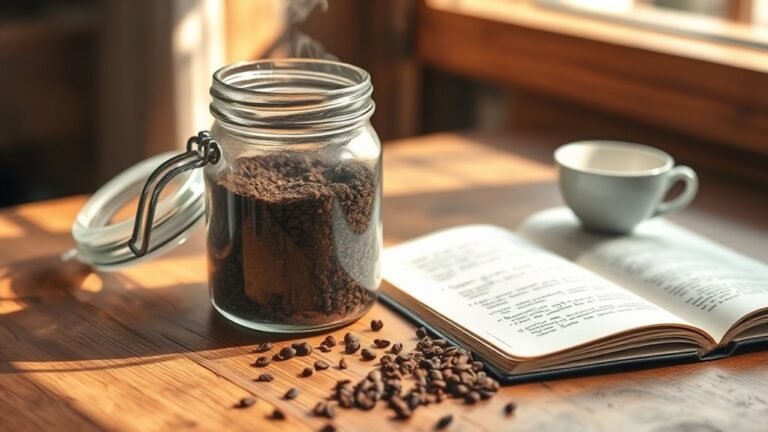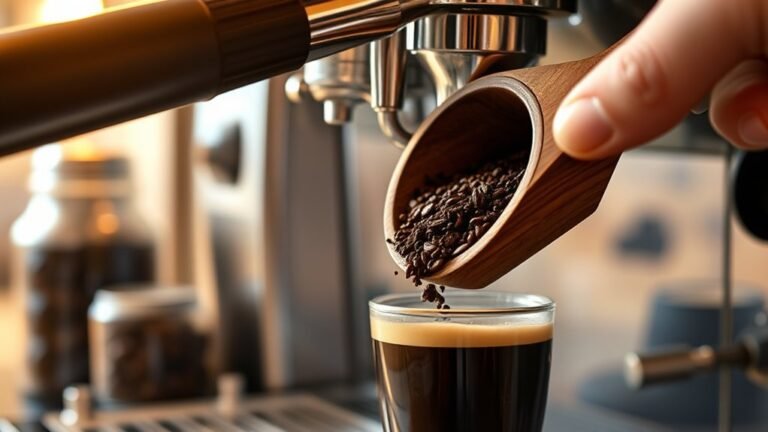Can I Make Regular Coffee With an Espresso Machine
Yes, you can definitely make regular coffee with an espresso machine. These machines aren’t just for espresso; they offer flexibility for different brewing methods. You can adjust the grind size and coffee-to-water ratio to suit your taste for a smoother brew. Using the steam wand can also enhance your coffee experience. By experimenting with various techniques and flavors, you’ll discover a world of coffee possibilities waiting for you. There’s much more to explore in this versatile brewing journey.
Understanding Espresso Machines

Espresso machines are fascinating devices that transform simple coffee grounds into rich, concentrated shots of espresso. Understanding the various espresso machine types, like manual, semi-automatic, and fully automatic, is essential for any coffee enthusiast. Each type offers a unique approach to espresso extraction methods, allowing you to tailor your brewing experience. Manual machines give you full control, while semi-automatics strike a balance between convenience and skill. Fully automatic machines simplify the process, but at the cost of some personal touch. By exploring these options, you can discover how each machine’s design influences flavor and strength, empowering you to make informed choices. Ultimately, your espresso journey can lead to a deeper appreciation of coffee, granting you the freedom to explore endless possibilities.
Brewing Techniques for Regular Coffee
When it comes to brewing regular coffee, understanding the differences between espresso and drip methods is essential. You’ll need to adjust the grind size to suit your chosen technique, as this can greatly impact flavor extraction. Let’s explore how these factors influence your daily cup and how you can master them effectively.
Espresso vs. Drip Methods
While both espresso and drip methods can produce a delightful cup of coffee, they each offer distinct brewing techniques that cater to different preferences and occasions. Espresso brewing focuses on high pressure and a short extraction time, resulting in a concentrated shot with rich flavors and a creamy crema. This method is perfect for those who crave intensity. On the other hand, drip coffee relies on gravity, allowing water to slowly flow through coffee grounds for a more subtle extraction. This technique yields a larger volume of coffee, ideal for leisurely mornings or gatherings. Ultimately, your choice depends on how you want to experience coffee—whether you’re after a bold shot or a smooth, easy-drinking cup.
Adjusting Grind Size
Adjusting the grind size of your coffee beans is essential for achieving the perfect cup, especially when using an espresso machine for regular coffee. The key is to find the right grind consistency that allows for ideal coffee extraction. A coarser grind can help mimic drip coffee, allowing water to flow through the grounds more freely and preventing over-extraction. Conversely, a fine grind can lead to bitter flavors if used for longer brewing times. Experiment with different grind sizes until you find one that complements your taste. Remember, the goal is to balance flavor and strength, so don’t hesitate to adjust as needed. With the right grind size, you’ll reveal the true potential of your espresso machine for brewing regular coffee.
Using the Steam Wand for Coffee
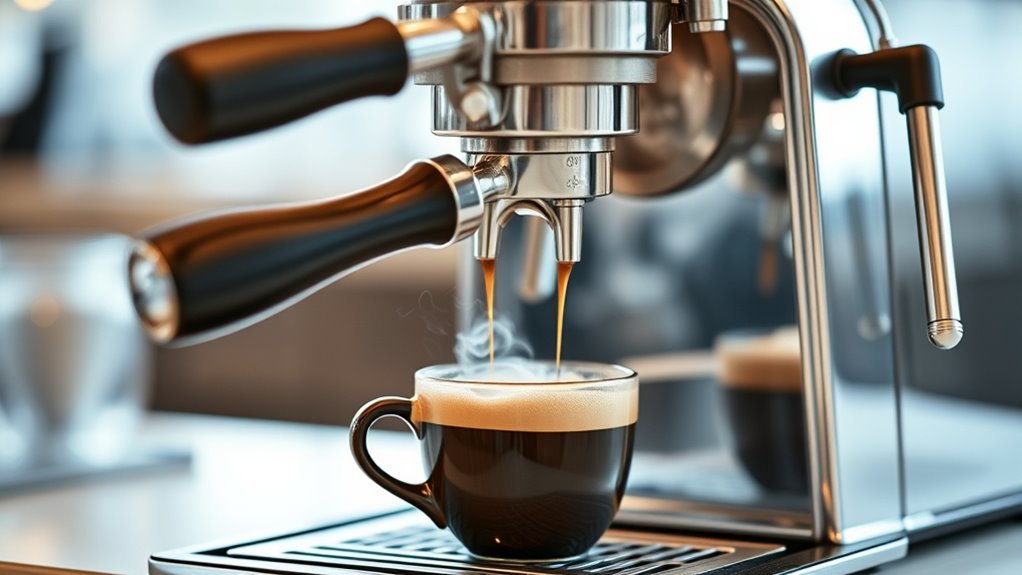
When using the steam wand for coffee, mastering frothing techniques can elevate your beverage to a café-quality level. You’ll also want to pay attention to steam wand maintenance to guarantee consistent performance and flavor. Finally, understanding the ideal milk temperature is essential for achieving that perfect texture and taste.
Frothing Milk Techniques
How can you achieve the perfect froth for your coffee using an espresso machine’s steam wand? Mastering frothing techniques is essential, and it can enhance your coffee experience. Start by choosing the right milk or milk alternatives; some froth better than others.
Here’s a quick comparison table to help:
| Milk Type | Froth Quality |
|---|---|
| Whole Milk | Creamy & Thick |
| Skim Milk | Light & Airy |
| Almond Milk | Moderate |
| Oat Milk | Creamy & Stable |
| Soy Milk | Variable |
To froth, submerge the steam wand just below the surface, tilt the pitcher, and create a whirlpool effect. This technique aerates the milk, resulting in a velvety texture. Enjoy your frothy creations!
Steam Wand Maintenance Tips
Although it might seem like a small part of your espresso machine, the steam wand requires regular maintenance to secure peak performance and quality froth. Neglecting it can lead to clogs and poor frothing results, impacting your coffee experience. Here are some maintenance routine tips to keep your steam wand in top shape:
- Purge after each use: This clears out any milk residue.
- Soak in warm water: Regularly soak the wand to dislodge stubborn buildup.
- Use a cleaning brush: Gently scrub the tip to remove any hidden debris.
- Inspect for damage: Regularly check for cracks or blockages to secure efficiency.
Ideal Milk Temperature
Achieving the perfect milk temperature is essential for enhancing the flavor and texture of your coffee, as it directly impacts the frothing process. Ideally, you want your milk to reach around 150°F to 155°F (65°C to 68°C) for ideal milk frothing. At this temperature, the milk’s natural sweetness is revealed, creating a rich, velvety texture. If you go too hot, over 160°F (71°C), you risk scalding the milk, which can lead to a burnt taste and poor froth quality. To maintain control, use a thermometer or gauge while steaming. Remember, practice makes perfect. Experiment with your machine to find that sweet spot, allowing you to enjoy a delightful cup that respects the essence of both milk and coffee.
Adjusting Grind Size and Coffee Ratio
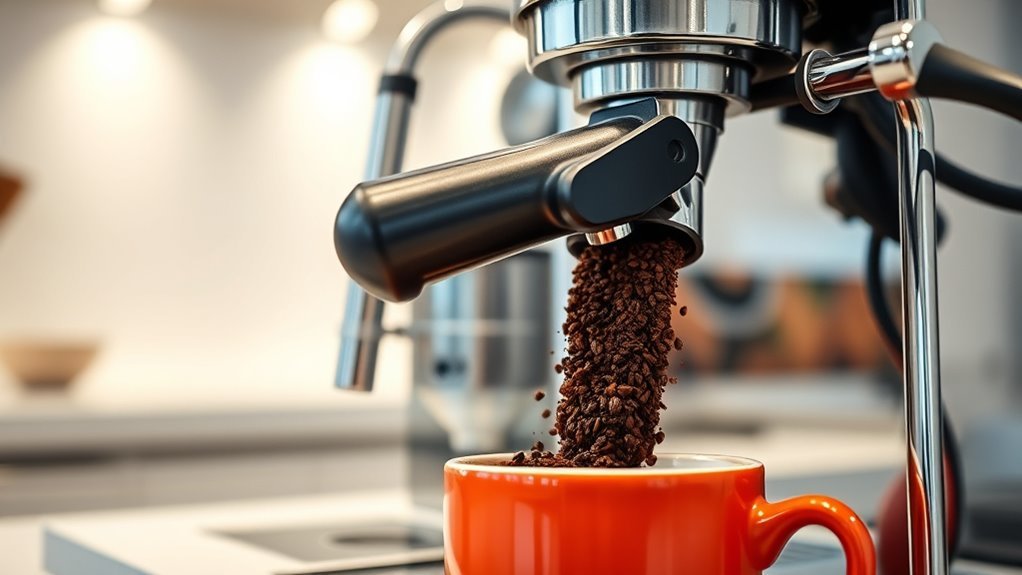
When you’re using an espresso machine to make regular coffee, adjusting the grind size and coffee ratio is essential for achieving the right flavor profile. Finding the perfect balance can reveal a world of taste and aroma. Here are some key points to reflect on:
Adjusting grind size and coffee ratio is crucial for perfecting flavor when using an espresso machine for regular coffee.
- Grind adjustments: A coarser grind works better for regular coffee, while finer grinds suit espresso.
- Coffee ratios: Experiment with a ratio of 1:15 to 1:18 (coffee to water) for a smoother brew.
- Brewing time: Longer extraction can enhance flavors; aim for 4-5 minutes.
- Taste testing: Don’t hesitate to tweak your grind and ratio based on your preference.
Tips for Enhancing Flavor
To enhance the flavor of your regular coffee made with an espresso machine, consider the impact of your water quality and temperature. Using filtered water can greatly improve taste, while keeping the temperature between 195°F to 205°F guarantees ideal extraction. Experimenting with flavor infusions can also elevate your brew; try adding a splash of vanilla or a hint of caramel during the brewing process. Spice additions, like a dash of cinnamon or nutmeg, can create a warm, inviting aroma and complexity. Don’t shy away from experimenting with different coffee beans, as their origin and roast level can remarkably affect flavor. With these tips, you can enjoy a rich, flavorful cup that meets your coffee desires.
Cleaning and Maintenance for Versatile Use
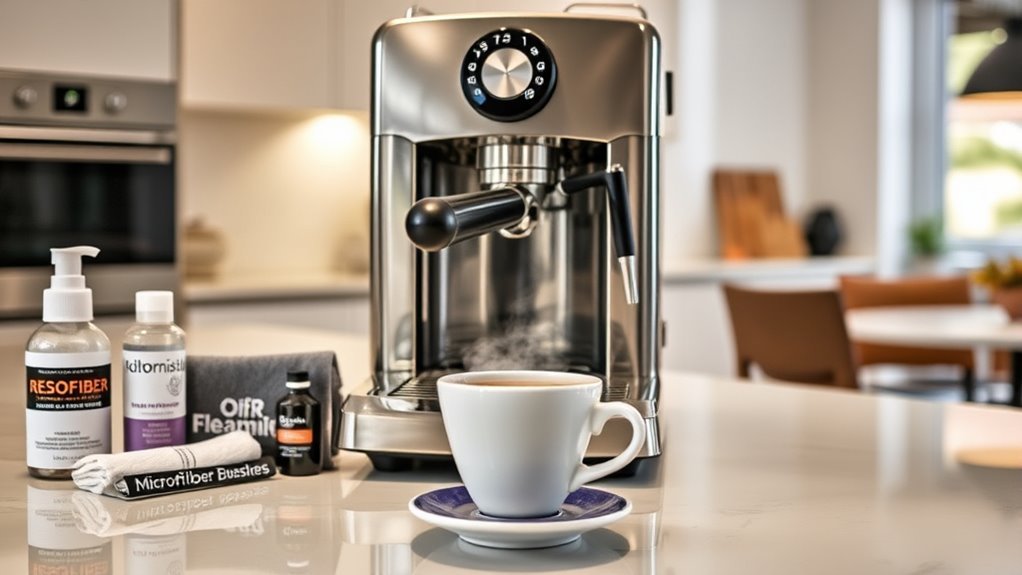
Although you might be enthusiastic to brew your next cup of coffee, maintaining your espresso machine is essential for achieving consistent quality. A proper cleaning schedule guarantees your machine remains versatile, allowing you to switch between espresso and regular coffee with ease. Here are some key maintenance tools you should have on hand:
- Soft brushes for portafilter and group heads
- Descaling solutions to remove mineral buildup
- Microfiber cloths for wiping surfaces
- Water filters to protect your machine
Frequently Asked Questions
Can I Use Regular Coffee Beans in an Espresso Machine?
You can definitely use regular coffee beans in an espresso machine, but the results might vary. Different coffee bean types can produce distinct flavors, and using a medium or light roast might yield a different experience than traditional espresso beans. Keep in mind that espresso brewing techniques emphasize fine grinding and high pressure, so adjusting your grind size and extraction time is essential for achieving the best taste. Experiment to find what suits your palate!
How Long Does It Take to Brew Coffee With an Espresso Machine?
Brewing coffee with an espresso machine typically takes about 25 to 30 seconds for ideal coffee extraction. During this time, hot water forces through finely-ground coffee, creating a rich, concentrated shot. If you want to experiment with different blends, remember that brewing time can vary slightly based on grind size and tamping pressure. Embracing this process allows you to enjoy a unique coffee experience that offers freedom in flavors and aromas.
Is an Espresso Machine More Expensive Than a Regular Coffee Maker?
When considering cost comparison, espresso machines generally are more expensive than regular coffee makers upfront. However, think about machine longevity; a high-quality espresso machine can last for years, potentially saving you money in the long run. If you’re passionate about coffee and enjoy experimenting with flavors, the investment might be worthwhile. Ultimately, your choice depends on how much you value those exquisite espresso shots versus a straightforward cup of coffee.
Can I Brew Cold Coffee With an Espresso Machine?
Creating cold coffee with an espresso machine can be a cool, creative endeavor. Though typically associated with hot brews, you can craft a revitalizing cold brew by pulling espresso shots and chilling them. Simply brew your espresso, then pour it over ice or combine it with cold milk or water. Experimenting with flavors can elevate your drink, giving you freedom to customize your cold coffee experience just the way you like it!
Do I Need Special Filters for Brewing Coffee in an Espresso Machine?
When brewing coffee in an espresso machine, you don’t necessarily need special filters, but the right filter types can enhance your experience. Most espresso machines use a metal or paper filter, depending on the brewing methods you prefer. Metal filters allow oils to pass through, creating a richer flavor, while paper filters can result in a cleaner cup. Ultimately, it’s about finding the balance that suits your taste and brewing style.

